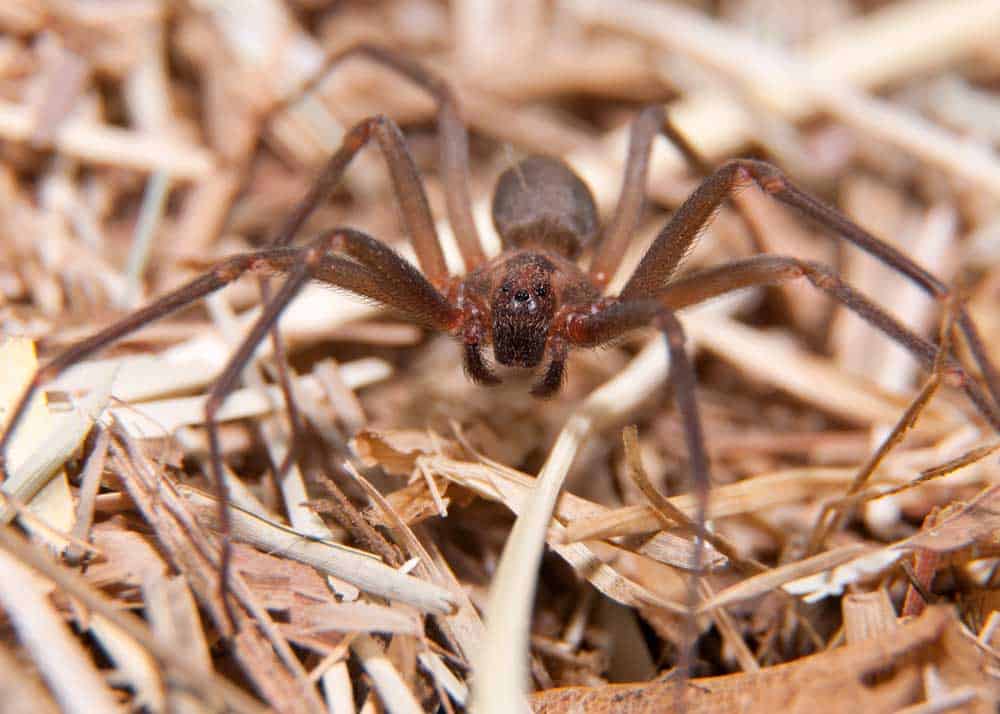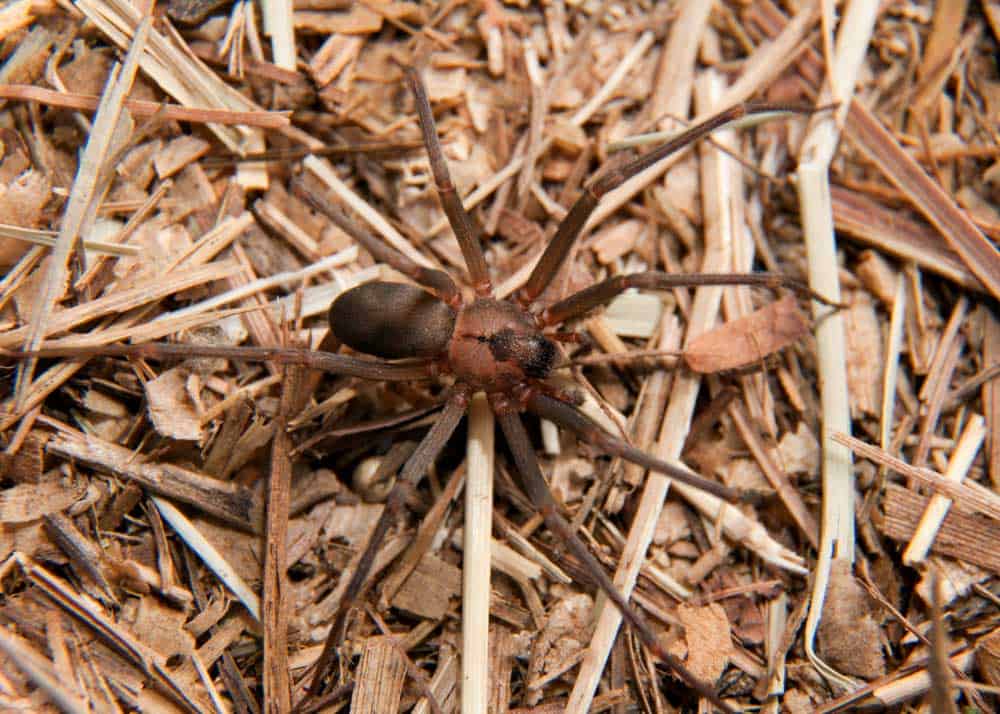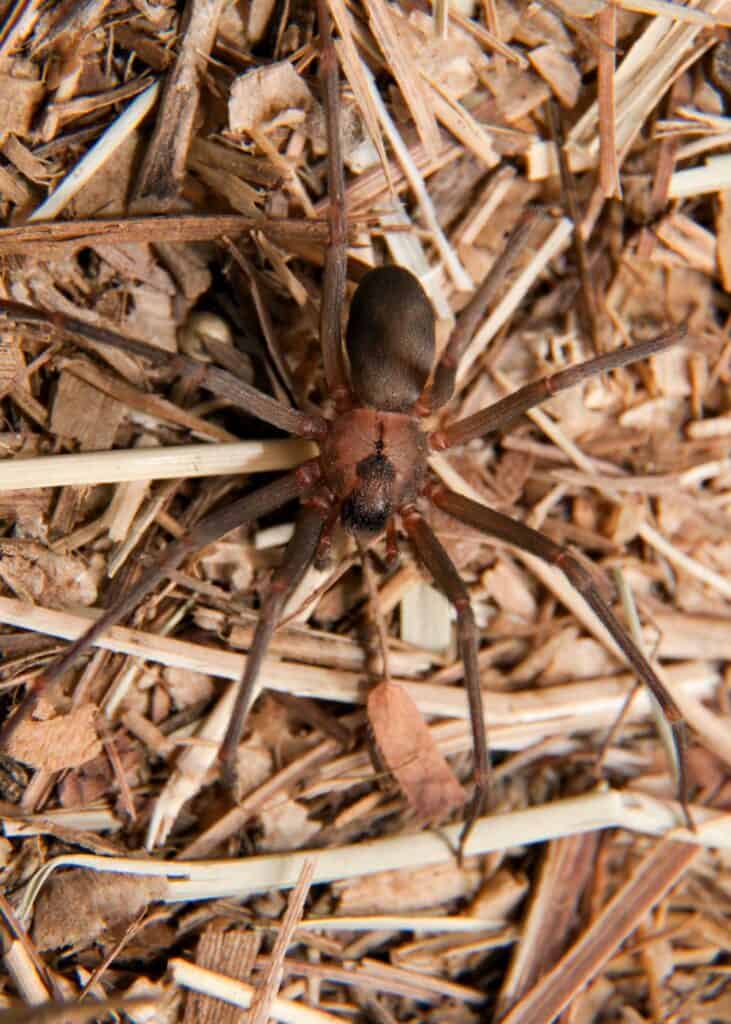The brown recluse spider is commonly found in the southern United States. It goes by a few nicknames and has a potentially fatal bite to humans. Learn more about these spiders and their venom, along with what happens when they bite.
Let’s jump into our brown recluse spider facts.

Table of Contents
Brown Recluse Spider Overview
- Latin Name: Loxosceles reclusa
- Location: Southern United States and parts of the Midwest and Southwest
- Habitat: Dark and dry areas that are quiet and private
- Size: ½ to ¼ inch
- Diet: Soft-bodied insects, including fleas and crickets
- Physical Features: Uniform legs and stomachs with no markings and tan to dark brown in color
- Lifespan: 1 to 2 years
Brown recluse spider: scientific classification
- Kingdom: Animalia
- Phylum: Arthropoda
- Class: Arachnida
- Order: Araneae
- Family: Sicariidae
- Genus: Loxosceles
- Species: L. reclusa
Facts About Brown Recluse Spiders
Does the brown recluse spider have any other names?
The brown recluse spider goes by several other names that you might hear people mention. Most of those names come from the markings on their backs that make it appear as though they carry a violin.
The brown recluse spider is also called a violin spider or brown fiddler. It also has the nickname of the fiddleback spider.
Where do brown recluse spiders live?
Most of these spiders live in the American South and portions of the Southwest and Midwest.
Brown recluse spiders are commonly found in Kansas, Texas, Arkansas, Louisiana, Alabama, Missouri, Mississippi, and Oklahoma.
A small number also live in southern parts of Ohio, Indiana, and Illinois, as well as Kentucky, Georgia, and Tennessee.
Some also found their way to Arizona, Utah, New Mexico, and California.
What is their habitat like?
These spiders prefer dark and dry areas such as linen closets and cabinets. Their habitats are quiet and usually in hidden areas of homes.
When found outside, they often live in woodpiles and sheds.

What does the brown recluse spider look like?
It’s often easy to mistake this type of spider with another because they look similar. Brown recluse spiders are usually tan to dark brown but may also appear in some gray shades.
They have six eyes arranged in a semicircular pattern on their faces with a dark brown marking on their back that resembles a violin. Many also have a straight brown line resembling the violin’s bow.
These spiders have long and thin legs and are usually ½ to ¼ inches long.
How much does the brown recluse spider weigh?
Brown recluse spiders are tiny and weigh just 0.001 lbs (0.45 grams).
What do brown recluse spiders eat?
Brown recluse spiders survive on other insects and prefer soft-bodied bugs. They usually eat other common household bugs such as fleas and roaches as well as moths and crickets.
When food is scarce, the spiders can become cannibalistic and eat each other.
Sometimes, wolf spiders are confused with brown recluse spiders. Here’s how to tell them apart: Brown Recluse vs Wolf Spider: 12 Differences
Are brown recluse spiders dangerous?
The media brought a lot of attention to these bugs with claims that they are extremely dangerous. They produce cytotoxic venom when they bite, which can become lethal.
As they often sleep during the day and only come out at night, they do not disturb others unless they view them as a threat. Brown recluses are dangerous to other insects though.
Death from brown recluse spider bites is rare. And have only been reported in children.
Did I get bitten by a brown recluse?
This is a complex question. Here is a mnemonic device to avoid false positives. It was produced by William V Stoecker, Richard S Vetter, and Jonathan A Dyer.
Often a bite from a presumed arachnid can be mistaken as a bite from the brown recluse spider. Most patients aren’t able to find the spider. A helpful mnemonic to use is NOT RECLUSE, to help exclude the cause of bite from a brown recluse spider.
N (numerous) – only one lesion is usually present in a brown recluse spider bite.
O (occurrence) – A bite usually occurs when disturbing the spider. As the name suggests, they tend to avoid people, hiding in dark spaces like in a box or the attic.
T (timing) – Most bites occur between April and October.
R (red center) – characteristic bites will have a pale central area secondary to the capillary bed destruction causing ischemia.
E (elevated) – Usually the bites are flat. If the area is elevated >1 cm, then this is most likely not a brown recluse spider bite.
C (chronic)- bites from a brown recluse spider most commonly heal within 3 months.
L (large) – Rarely are these bites >10 cm.
U (Ulcerates too early) – If the bite is from a brown recluse spider, they do not ulcerate until 7-14 days.
S (swollen) – often brown recluse spider bites do not exhibit significant swelling unless they occur on the face or the feet
E (exudative) – brown recluse spider bites do not cause exudative lesions
The above is an excerpt from this document:
Can brown recluse spiders hurt humans?
Yes, brown recluse spiders can hurt humans.
There is mixed research on how dangerous brown recluse spiders are to humans. Most agree that the spiders will not attack unless they feel threatened or think someone will harm their dens/webs.
As the spiders can live in clothing and other places where humans spend time, there is a chance that they will attack. Roughly 90% of brown recluse spider bites do not require medical attention. The victim will recover at home within two to three months.
A potential problem is that the bite can cause an infection. This commonly affects those who have weakened immune systems such as children and the elderly along with those who have medical conditions that include diabetes.
When they attempt to treat the bite at home, it can lead to a secondary infection that causes a fever and other symptoms. Anyone bitten by one of these spiders should talk to a doctor.
Brown recluse are common in parts of the United States. Here are other common house spiders.
What does a brown recluse spider bite look like?
People bitten by brown recluse spiders can experience different symptoms. While some people do not react to the bite, others have a delayed reaction that they do not see for several days or hours.
Some found that the bite went away on its own, but others developed a small scar from the bite.
Those with a more serious reaction often notice a small spot on their skin that looks like a blister with a white surface. As the spot changes, it can turn bright red or blue or even feature a combination of colors.
Some refer to this as a volcano lesion because it appears as though it might erupt.
Others call it a red, white, and blue bite due to those colors. In more serious cases, the blister breaks open and leaves behind a gaping wound. It can take eight weeks or longer, for someone to heal from the bite.
What are the side effects of a bite? How do you care for it?
Common side effects associated with a brown recluse spider bite include fever and chills along with nausea and sweating. Some also experience itching at the bite spot and a general feeling of being unwell.
If you or someone you know suffers from a brown recluse spider bite, call 911 and explain the situation. The operator will likely recommend that you visit the ER or talk to your doctor. You should wash the bite with soap and warm water before placing an ice pack on the spot for 10 minutes.
Rest the affected area for 10 minutes before using ice again. Your doctor may prescribe antibiotics and/or a painkiller, depending on your symptoms.
We aren’t doctors. You should call a doctor. While on hold, you can also visit WebMD or this page by the Government of Alberta.
Are there brown recluse spiders in Canada?
There may be brown recluse spiders in Canada. There are reports from Nova Scotia and Ontario.
And a project by the University of Toronto to track and confirm sightings and bites.
How do brown recluse spiders hunt?
Though the brown recluse spider spins a web, it does not always use this web to trap prey. The spiders are nocturnal hunters.
They usually sleep during the day and hunt at night. These spiders are unlike other types as they prefer hunting for prey in the area and chasing it down. They sink their fangs into the victim and release enough venom to immobile them.
Are brown recluse spiders monogamous?
These spiders are not monogamous. The females can mate with many men during the mating season.
Though they can live on their own, they can also live together.
How do they mate?
The males and females of these species only come together during the mating season. As a way to woo the female and capture her attention, the male will dance in front of her.
If she accepts him, they will mate. She may also turn him down, which forces the male to find food and bring it to her until she accepts him.
How many eggs do brown recluse spiders lay?
Brown recluse spiders lay egg sacs that contain all of their babies. The sacs can have a cone shape or appear more rounded and range in color from off-white to tan.
A single sac can hold up to 300 babies. More commonly, there are roughly 50 eggs per sac. Baby spiders are called spiderings.
Do they live in nests?
As the name implies, these spiders prefer to live on their own. They can live in small groups, especially in homes.
Most of the spiders spin webs and use the webs as their homes. Those that live outside can build nests or dens in old wood piles or furniture.
Don’t like spiders in your home? Here’s how to get rid of spiders.
Are brown recluse spiders endangered?
Brown recluse spiders are not endangered and live in large numbers in certain states.
Scientists in California collected around 20 of the spiders over the years, but significantly more are found in the south.
How long do brown recluse spiders live?
These spiders have a shorter lifespan than other insects but live longer than others found around homes. They have an average lifespan of one to two years.
More reading: 8 Legged Insect Guide

Learn more about another famous spider: Guide to Banana Spiders
Did you learn something about the brown recluse spider that interested you? Share your thoughts below and tell your friends about this fascinating spider that isn’t quite as deadly as you thought.
- About the Author
- Latest Posts
Bryan Haines is a co-founder and writer at The Buginator. And is working to make it the best resource for taking back the outdoors from biting, stinging pests.
He also blogs about travel at Storyteller.Travel and photography at Storyteller Tech. Bryan is a partner at Storyteller Media, a publishing company he runs with his wife, Dena.

Sherry
Wednesday 19th of July 2023
Brown Recluse spiders are also found in the Northeast states including New England. A friend of ours living in Kittry Me. was bitten by one and ended up in the hospital.